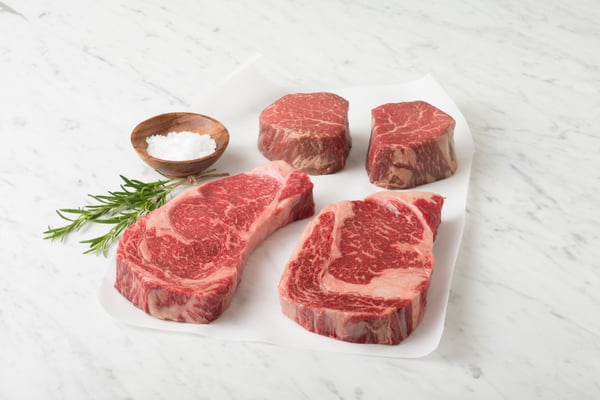
When measured on a U.S. scale, Wagyu beef is literally off the charts. That’s why we need to refer to the standards of the Japanese Meat Grading Association (JMGA) to accurately score this outrageously fine beef.
What is an A5 rating?
The JMGA developed a beef carcass grading standard to measure carcasses with higher marbling scores. Wagyu beef often exceeds USDA Prime, so that’s why it makes more sense to use the JMGA scale, which is an alphanumeric rating system. The letter (A, B, or C) refers to the yield of the carcass, meaning how much of the meat on the animal was usable.
- A: 72% and above
- B: 69% and above
- C: Under 69%
The number (1-5) is arguably more important to the consumer and refers to the quality of the meat. To figure out this number, graders look at the marbling, meat color, brightness, firmness and texture, luster, and quality of the fat.
- Poor
- Below average
- Average
- Good
- Excellent
The marbling is first rated on a separate scale, the Beef Marbling Standard (BMS), and given a score somewhere between 1-12 before being converted to the 1-5 scale. In order to be rated A5, the marbling must score between 8-12 on the BMS scale.
An A5 rating is extremely difficult to achieve. JMGA graders must train for 2-3 years before being considered competent in rating Japanese Wagyu. And even then, three expert graders must examine each carcass. Their combined score determines the final rating.
How does it compare with USDA Prime, Choice, and Select?
Wagyu beef often exceeds USDA Prime, which is the highest rating by USDA standards. The USDA separates beef into eight different grades, the top three of which are:
- Select: fairly tender, but with less marbling; more uniform and leaner than higher grades
- Choice: high quality, but with less marbling than prime
- Prime: produced from young, well-fed beef cattle; very high quality with abundant marbling
Angus beef, the most predominant beef in the U.S., achieves an average BMS score of only 2, and rarely meets its maximum BMS score of 5. This means that Angus beef barely registers on the JMGA scale, whereas a large amount of fullblood Wagyu beef achieves a rating of A3 or A4, which are extremely desirable ratings, fetching high prices.
How would you prepare A5 beef?
A5 is off-the-charts good. It’s the most luxurious, tender, unbelievably marbled, and decadent beef. For that reason, it’s best enjoyed in small portions due to its richness.
Tips for preparing A5 meat:
- Slice into small strips and cook one at a time.
- Sprinkle just a dash of salt and pepper on the meat—it’s naturally rich and flavorful.
- Cook on stainless steel.
- Sear the meat slices approximately 1 inch by 4 inches directly on the hot surface of the pan for a minute or two.
- Let the fat melt out and use it to cook the meat.
Where can you find A5 beef?
You won’t find A5 beef in grocery stores, because most of it goes straight to fancy restaurants and hotels. It’s also incredibly difficult to ship A5 meat without risking its quality. For that reason, A5 beef may be better enjoyed at a restaurant than at home.
Not all Wagyu beef has an A5 rating, but even A4 beef is likely to be some of the best meat you’ve had in your life. If you’re looking to taste the best of the best, we recommend starting with our unbelievably marbled, decadent filet mignon.





